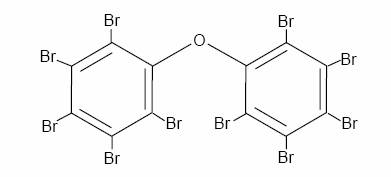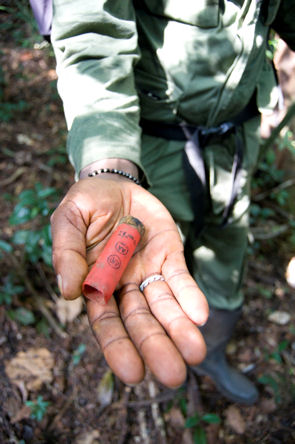The following is a list of the chemicals currently being monitored by the PBMS with a paragraph explaining which organisms are monitored and why. Click on the chemical name for full details.
Polybrominated Diphenyl Ethers (PBDEs).
Second Generation Anticoagulant Rodenticides (SGARs).
Lead (Pb).
Mercury (Hg).
Other toxic and essential metals.
Polybrominated Diphenyl Ethers (PBDEs)
Monitored in otter livers (started in 2010); the highest brominated PBDE, Decabromodiphenyl ether (DecaBDE), is monitored in sparrowhawk eggs.
Where do they come from?
PBDEs have been widely used as flame retardants added to furniture foams and different plastics. PBDEs may be released into the environment during their manufacture and through use and disposal of manufactured products. They are also continually released from products as part of their functional operation, producing non-combustible gases that both scavenge free radicals and dilute flammable gases. PBDEs can therefore enter the environment through direct emission to air as gas or dust, by release to land and surface water, and via sewage and landfill.
their manufacture and through use and disposal of manufactured products. They are also continually released from products as part of their functional operation, producing non-combustible gases that both scavenge free radicals and dilute flammable gases. PBDEs can therefore enter the environment through direct emission to air as gas or dust, by release to land and surface water, and via sewage and landfill.
Why do we monitor them?
Concerns over rising environmental concentrations and toxicity have led to phasing out or bans of lower brominated diphenyl ethers in North America and Europe since 2004. In the  EU, DeBDE has been subject to considerable legislative review and scrutiny under the Registration, Evaluation, Authorisation and Restriction of Chemicals (REACH) regulations but it is currently unrestricted for non-electronic/electrical uses, which makes up the bulk of its applications. Commercial pentabromodiphenyl ether has now been included into Stockholm Convention on Persistent Organic Pollutants (POPs). The monitoring carried out as part of the PBMS will help us measure whether these restrictions are effective in reducing contamination of the environment with these compounds.
EU, DeBDE has been subject to considerable legislative review and scrutiny under the Registration, Evaluation, Authorisation and Restriction of Chemicals (REACH) regulations but it is currently unrestricted for non-electronic/electrical uses, which makes up the bulk of its applications. Commercial pentabromodiphenyl ether has now been included into Stockholm Convention on Persistent Organic Pollutants (POPs). The monitoring carried out as part of the PBMS will help us measure whether these restrictions are effective in reducing contamination of the environment with these compounds.
#top
Second Generation Anticoagulant Rodenticides (SGARs)
Monitored in the livers of barn owls, kestrels, & red kites.
Where do they come from?
SGARs are widely used to control pest rodent populations and provide economic and health benefits. Monitoring studies have shown that exposure of non-target species can occur either through primary or secondary exposure.
Primary exposure is particularly likely amongst invertebrates and granivorous vertebrates. Secondary exposure of some predatory birds and mammal species, such as the red kite, buzzard, polecat and red fox may in part or largely be due to them preying on commensal mammals that are the targets of control. However, other species that rarely feed on commensal rodents also accumulate liver residues of SGARs. These include a wide range of raptors and mustelids and even in species such as the Eurasian otter.
Why do we monitor them?
Second generation anticoagulant rodenticides (SGARs) can be toxic to all mammals and birds. Predators that feed upon rodents are particularly likely to be exposed to these compounds. The PBMS together with other studies have shown that there is widespread exposure to SGARs of a diverse range of predators in Britain. Defra’s Wildlife Incident Monitoring Scheme (WIIS) and the PBMS have shown that in the UK some mortalities result from this exposure.
In response to conservation concerns over the potential impacts of SGARs on predators, the PBMS has monitored trends in exposure to second generation anticoagulant rodenticides (SGARs) in a sentinel species, the barn owl (Tyto alba). This has been done since 1983 and the findings from previous years and analyses of long-term trends are given in previous PBMS reports. The red kite (Milvus milvus) is a high conservation priority species that has been reintroduced to England as part of Natural England’s reintroduction programme.
Kestrels (Falco tinnunculus) have been monitored since 2000 following a pilot study that demonstrated a relatively high level of exposure compared with barn owls and conservation concerns over declines in kestrel populations.
#top
Lead (Pb)
Monitored in red kite & sparrowhawk livers and gannet eggs.
Where do they come from?
Sources of Pb in the environment include lead mining, the refining and smelting of lead and other metals, the manufacture and use of alkyl lead fuel additives, and the use of lead ammunition.
Why do we monitor them?
Lead (Pb) is a highly toxic metal that acts as a non-specific poison affecting all body systems and has no known biological requirement.
#top
Mercury (Hg)
Monitored in red kite & sparrowhawk livers and gannet eggs.
Where do they come from?
Atmospheric pollution from industrial production is probably low, but pollution of water by mine tailings is significant. The burning of fossil fuels is a source of mercury. The chloralkali industry and, previously, the wood pulping industry also released significant amounts of Hg. Although the use of mercury is reducing, high concentrations of the metal are still present in sediments associated with the industrial applications of mercury. Some Hg compounds have been used in agriculture, principally as fungicides.
Why do we monitor them?
Residues of mercury in birds' eggs have been associated with deaths of embryos in shell. The presence of organochlorine residues in the same birds and their eggs makes an accurate assessment of the effects of mercury difficult. It is, however, thought to be a contributing factor in the population decline of some species of raptors.
The global transport and deposition of mercury has increased in recent years due to changes in atmospheric chemistry and so we continue to monitor Hg to assess whether Hg residues in raptor tissues and eggs will rise to reflect these changes.
#top
Other toxic and essential metals monitored in red kite & sparrowhawk livers and gannet eggs.
| Analyte | Chemical symbol | Metal, metalloid or non-metal; toxic, essential or trace |
|---|---|---|
| Aluminum | Al | Toxic metal |
| Arsenic | As | Toxic metalloid |
| Antimony | Sb | Toxic metalloid |
| Cadmium | Cd | Toxic metal |
| Chromium | Cr | Trace metal |
| Cobalt | Co | Essential metal |
| Copper | Cu | Essential metal |
| Iron | Fe | Essential metal |
| Manganese | Mn | Essential metal |
| Mercury | Hg | Toxic metal |
| Molybdenum | Mo | Essential metal |
| Nickel | Ni | Trace metal |
| Selenium | Se | Essential non-metal element |
| Strontium | Sr | Trace metal |
| Zinc | Zn | Essential metal |
| Vanadium | V | Trace metal |
Key
Toxic – no known biological function and can cause adverse effects in vertebrates.
Essential – required for the normal functioning of physiology in vertebrates.
Trace – unclear whether this element has a biological function in vertebrates, but not known to cause adverse effects in vertebrates.
Metalloid – a semi-metal exhibiting physiochemical properties that are in-between or a mixture of those of metals and non-metals.
Element – a non-metal.
Where do they come from?
Sources differ among the metals and semi-metals monitored.
Why do we monitor them?
The analytical techniques employed to monitor lead & mercury allows us to measure the concentrations of a further 14 elements. Some of these elements are essential for the health of the birds so we are collecting data to investigate how exposure to toxic metals may affect the balance of these essential elements.
#top






